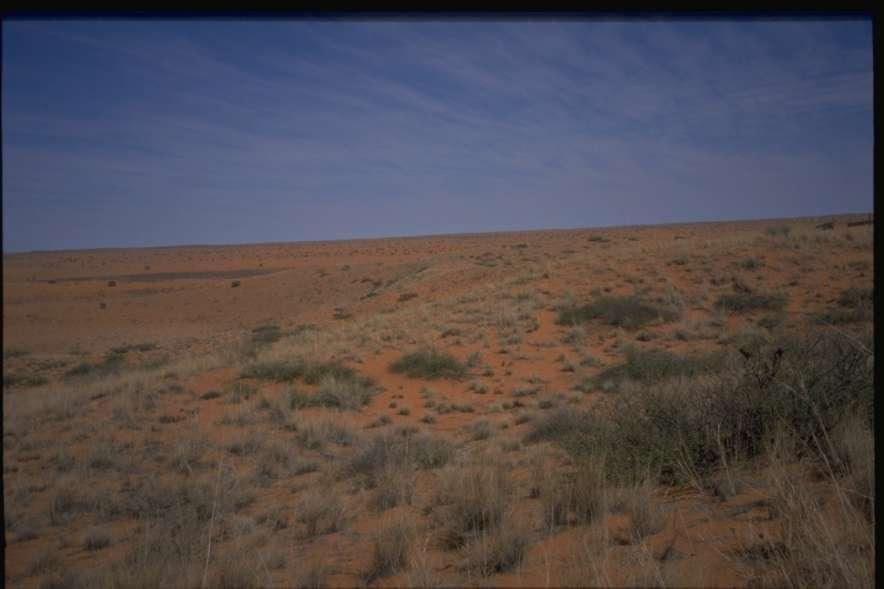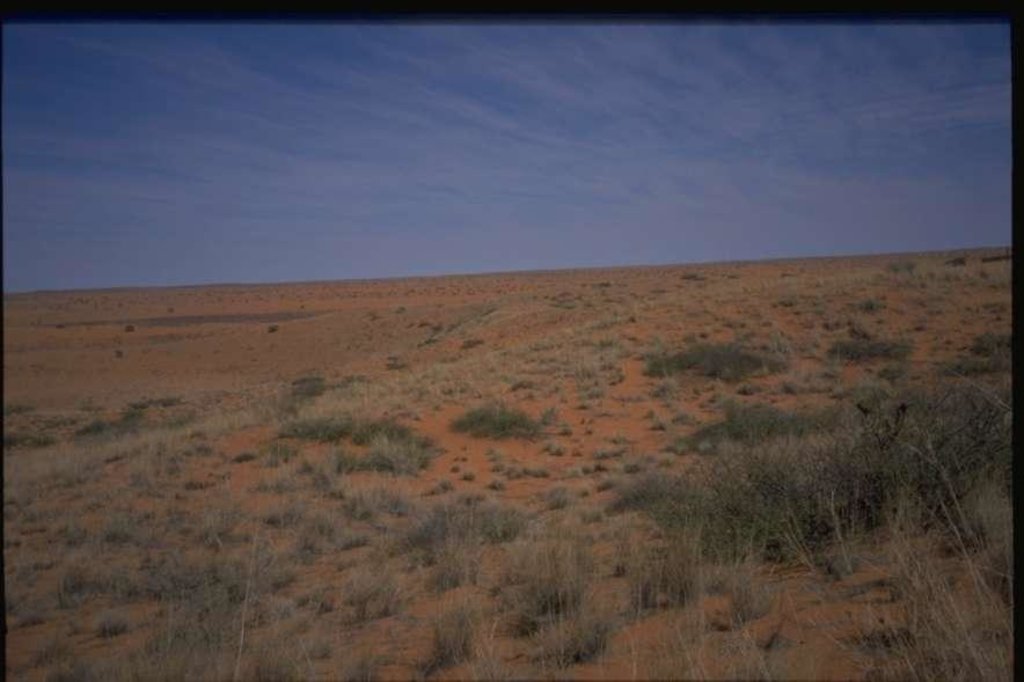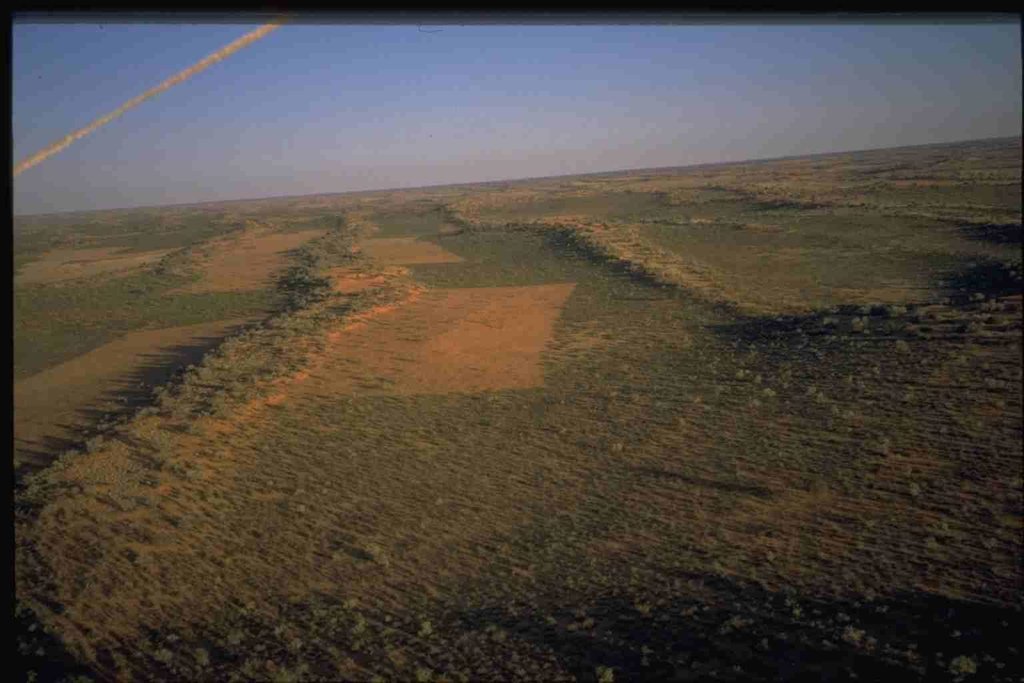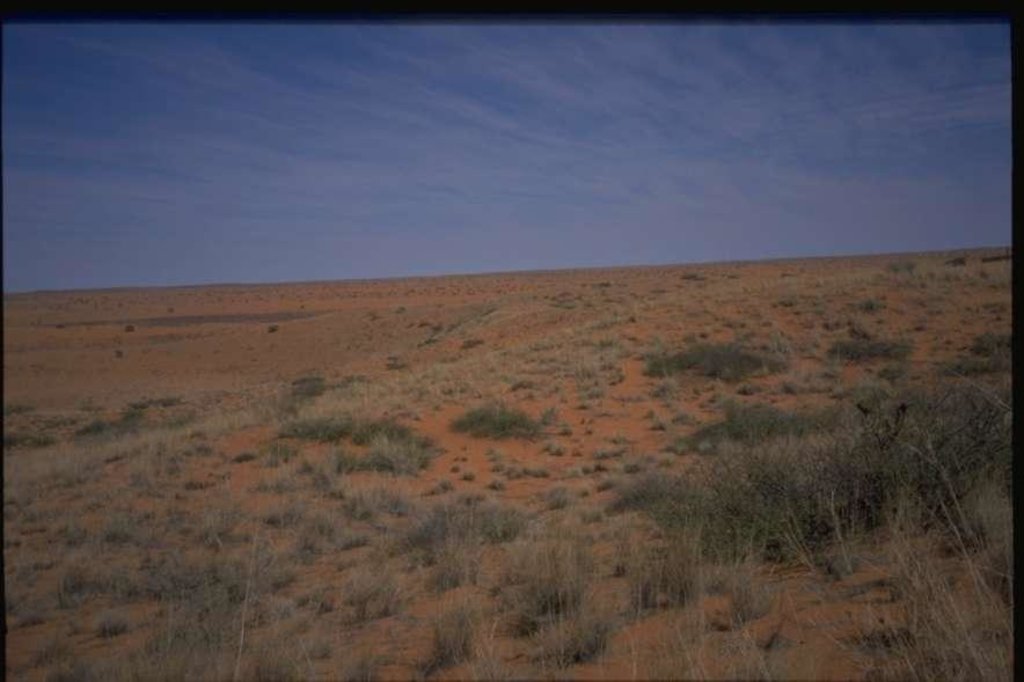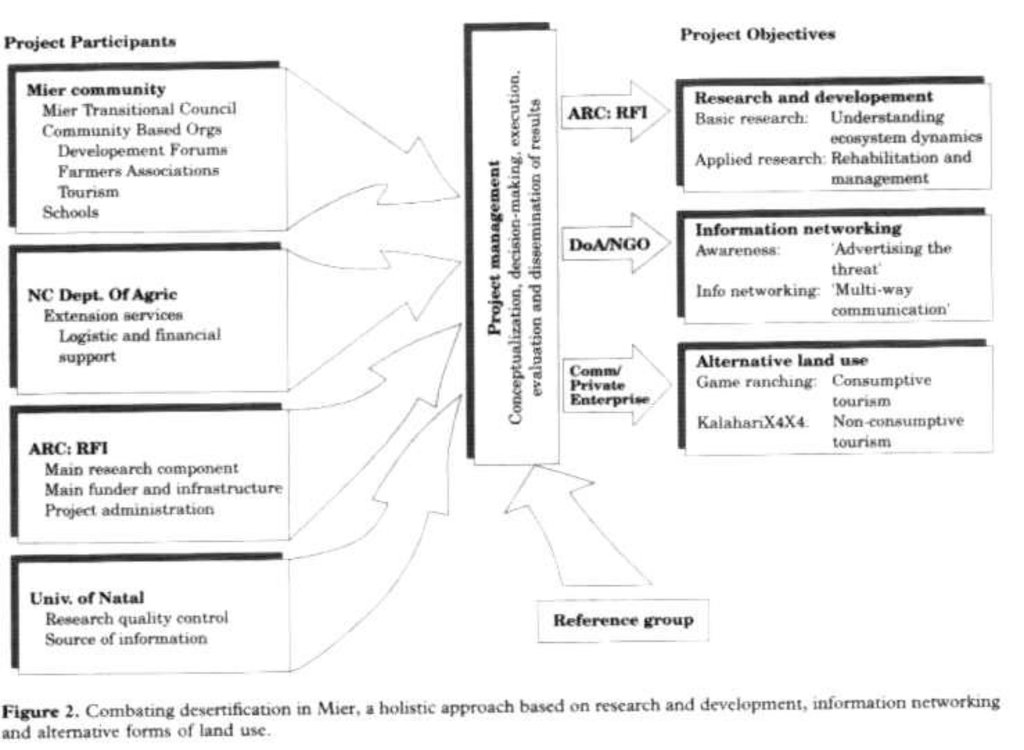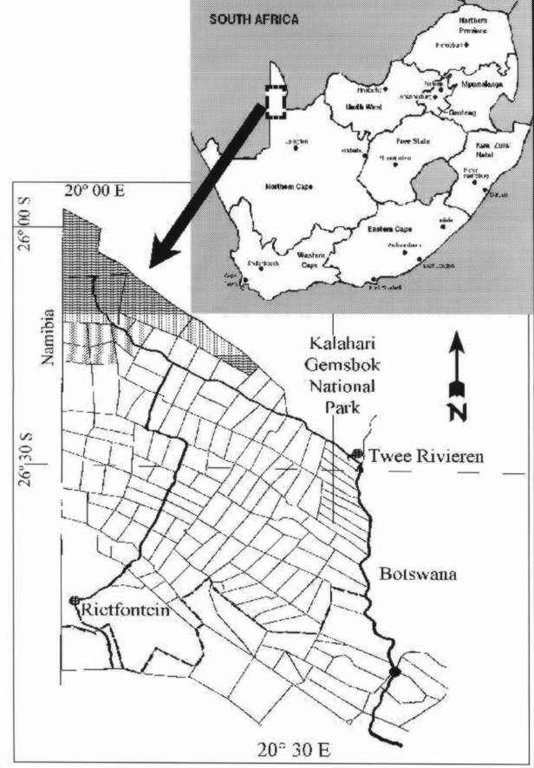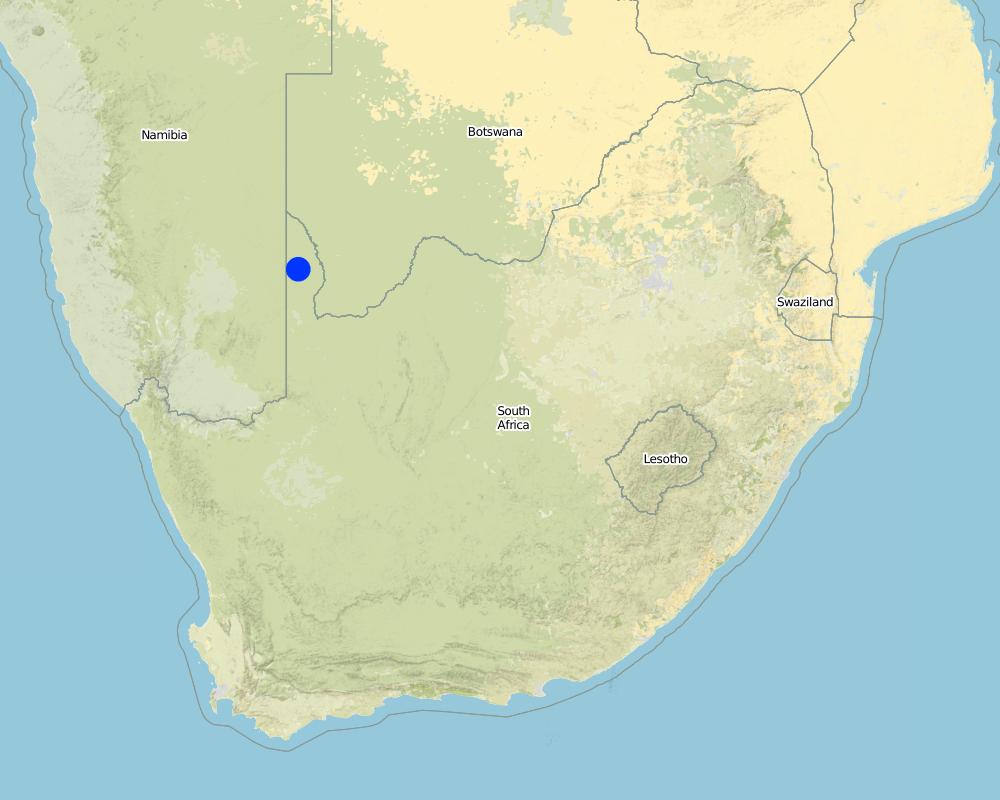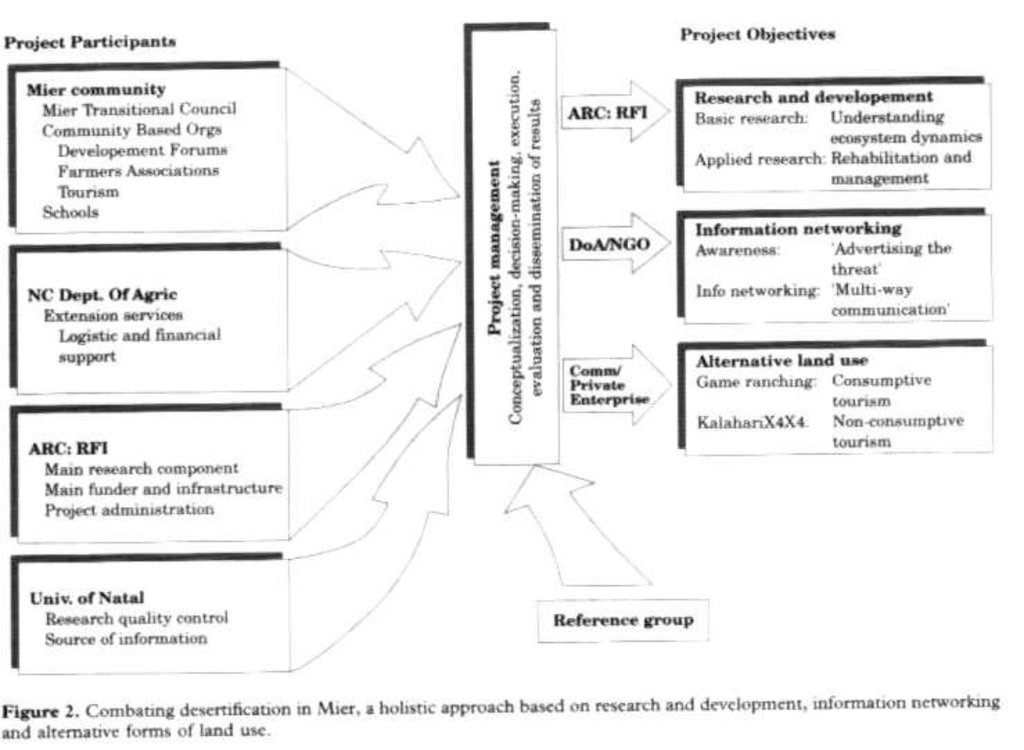Rehabilitation techniques in southern Kalahari - Vegetative and Management [South Africa]
- Creation:
- Update:
- Compiler: Andre F. Van Rooyen
- Editor: –
- Reviewer: Fabian Ottiger
approaches_2335 - South Africa
View sections
Expand all Collapse all1. General information
1.2 Contact details of resource persons and institutions involved in the assessment and documentation of the Approach
SLM specialist:
Smith Desmond
054-4611415
Northern Cape. Department of Agriculture
South Africa
Name of the institution(s) which facilitated the documentation/ evaluation of the Approach (if relevant)
Dept. of Agriculture, Northern Cape (Dept. of Agriculture, Northern Cape) - South Africa1.3 Conditions regarding the use of data documented through WOCAT
The compiler and key resource person(s) accept the conditions regarding the use of data documented through WOCAT:
Yes
2. Description of the SLM Approach
2.1 Short description of the Approach
Shared interest by Mier Management Council and Provincial Department of Agriculture
2.2 Detailed description of the Approach
Detailed description of the Approach:
Aims / objectives: Initially a combined effort by Department of Agriculture and Mier Management Council to combat degradation of game camps. Directed towards a male dominated farming community, also involving a few females (ages ranging from middle to old age). An objective was to educate towards awareness to degradation and techniques involving the rehabilitation of these areas and the prevention of getting to this state. Also including methods which prevent returning to this state. Initially using farmer???s days - education. Research came later, focussing on understanding the ecology of the area and then to concentrate on rehabilitation techniques. This was later introduced in farmer???s days, school education and education of management council. Stages of implementation: 1) Realisation by management council that veld was degraded. 2) Department of Agriculture requested to assist ??¡§ in the form of trial and error (i.e. resting camps, poisoning of shrubs). 3) Resting of camps showed no improvement, so Department requested assistance from Agricultural Research Council (Range and Forage Institute) to gain understanding of ecology of area. 4) Once understanding gained and techniques developed, education in the form of farmer???s days, school days and management council. Role of participants: 1) Nature Conservation: Initially involved in game number management. 2) Department of Agriculture: Advisory capacity management of techniques. 3) ARC - Research and advisory. 4) Management council ??¡§ labour control. 5) Community - involved through council in decision-making ??¡§ also jobs provided through labour.
2.3 Photos of the Approach
2.5 Country/ region/ locations where the Approach has been applied
Country:
South Africa
Region/ State/ Province:
Northern Cape
Map
×2.6 Dates of initiation and termination of the Approach
Indicate year of initiation:
1988
2.7 Type of Approach
- project/ programme based
2.8 Main aims/ objectives of the Approach
The Approach focused mainly on SLM with other activities (Income generation for tax subsidy in the community, job creation for males in the community, land care, development of eco-tourism, collaboration with local leadership)
Education ??¡§ in techniques to combat desertification, also in prevention of degradation Financial empowerment Management techniques
The SLM Approach addressed the following problems: Finance, education (very little education with regards to labours)
2.9 Conditions enabling or hindering implementation of the Technology/ Technologies applied under the Approach
availability/ access to financial resources and services
- hindering
Very poor community
Treatment through the SLM Approach: Landcare (money)
institutional setting
- hindering
Financial - no money in Institute and Department
Treatment through the SLM Approach: Money
legal framework (land tenure, land and water use rights)
- enabling
The existing land ownership, land use rights / water rights moderately helped the approach implementation: Hinder: moderate Farm-government won???t allow farmers to own land so attitude can be negative. Community reaps benefits from game farms.
other
- hindering
Political: leads to mistrust and uneasiness w.r.t. Money
Treatment through the SLM Approach: Work on the problem at hand and ignore politics
3. Participation and roles of stakeholders involved
3.1 Stakeholders involved in the Approach and their roles
- local land users/ local communities
Working land users were mainly men (Women did not work on project because of long distance to work).
Labour, management.
Labour work far too heavy for women (injuries have occurred). Women are directed towards cultivation techniques of Harpagophytum procumbens or basic homeskills (sewing etc.) Males - chopping & packing Rhigozum on dunes (degraded dunes).
- teachers/ school children/ students
- NGO
Research, management, education
- national government (planners, decision-makers)
Funding
3.2 Involvement of local land users/ local communities in the different phases of the Approach
| Involvement of local land users/ local communities | Specify who was involved and describe activities | |
|---|---|---|
| initiation/ motivation | passive | workshops/seminars, public meetings; Discussions to indicate where researchers see the project going and how the land users would like to see it go. |
| planning | interactive | workshops/seminars, public meetings; Field workshops & meetings-discuss how and where the project should be carried out. |
| implementation | external support | responsibility for major steps; Labour used for bushpacking responsibility for LandCare committee for salaries and labour. |
| monitoring/ evaluation | none | public meetings,measurements/observations, reporting, workshop/seminars; Monitoring of project is on going by researchers with help of few labours. Congresses/workshops are used to describe process & public meetings allow community to be informed. |
| Research | none | on-station; On-farm & on-station is ongoing. Lab work for information on germination processes. |
3.3 Flow chart (if available)
3.4 Decision-making on the selection of SLM Technology/ Technologies
Specify who decided on the selection of the Technology/ Technologies to be implemented:
- mainly SLM specialists, following consultation with land users
Explain:
land user driven (bottom-up). Knowledge of the area
Decisions on the method of implementing the SLM Technology were made by mainly by SLM specialists with consultation of land users. directive (top-down). Management due to low education
4. Technical support, capacity building, and knowledge management
4.1 Capacity building/ training
Was training provided to land users/ other stakeholders?
Yes
Specify who was trained:
- land users
- school children/students, planners, politicians/decision makers
Form of training:
- farmer-to-farmer
- demonstration areas
Subjects covered:
Rehabilitation ecological processes, cultivation, preventative agriculture
4.2 Advisory service
Do land users have access to an advisory service?
Yes
Specify whether advisory service is provided:
- on land users' fields
- at permanent centres
Describe/ comments:
Name of method used for advisory service: Not formal approach; Key elements: Education, Labour, Development; 1) Advisory service was carried out through: government's existing extension system Extension staff: mainly government employees 3) Target groups for extension: land users, school children/students; Activities: Bushpacking techniques, education; Education
Advisory service is inadequate to ensure the continuation of land conservation activities; The project is still in first phase - next phase will include female portion of community.
4.3 Institution strengthening (organizational development)
Have institutions been established or strengthened through the Approach?
- yes, a little
Specify the level(s) at which institutions have been strengthened or established:
- local
Specify type of support:
- equipment
- advise
4.4 Monitoring and evaluation
Is monitoring and evaluation part of the Approach?
Yes
Comments:
bio-physical aspects were regular monitored through measurements
technical aspects were ad hoc monitored through observations
socio-cultural aspects were ad hoc monitored hrough observations
economic / production aspects were regular monitored through measurements
area treated aspects were regular monitored through measurements
no. of land users involved aspects were ad hoc monitored through observations
management of Approach aspects were ad hoc monitored through observations
There were few changes in the Approach as a result of monitoring and evaluation: Packing designs of Rhigozum plants on bare dunes. The less expensive, most efficient design was chosen.
4.5 Research
Was research part of the Approach?
Yes
Specify topics:
- ecology
Give further details and indicate who did the research:
Rehabilitation techniques must fall within the capabilities and finance of the community.
Research was carried out on-farm
5. Financing and external material support
5.1 Annual budget for the SLM component of the Approach
Comments (e.g. main sources of funding/ major donors):
Approach costs were met by the following donors: government (national): 80.0%; local community / land user(s) (-): 20.0%
5.2 Financial/ material support provided to land users
Did land users receive financial/ material support for implementing the Technology/ Technologies?
Yes
5.3 Subsidies for specific inputs (including labour)
- equipment
| Specify which inputs were subsidised | To which extent | Specify subsidies |
|---|---|---|
| machinery | fully financed | |
| tools | fully financed | |
- agricultural
| Specify which inputs were subsidised | To which extent | Specify subsidies |
|---|---|---|
| seeds | fully financed | |
| fertilizers | fully financed | |
- other
| Other (specify) | To which extent | Specify subsidies |
|---|---|---|
| Food and transport | fully financed |
If labour by land users was a substantial input, was it:
- paid in cash
6. Impact analysis and concluding statements
6.1 Impacts of the Approach
Did the Approach help land users to implement and maintain SLM Technologies?
- No
- Yes, little
- Yes, moderately
- Yes, greatly
Stabilisation of dunes, greater vegetation on dunes.
Did the Approach improve issues of land tenure/ user rights that hindered implementation of SLM Technologies?
- No
- Yes, little
- Yes, moderately
- Yes, greatly
Farmers realised the simplicity of rehabilitation. The problem is likely to be overcome in the near future. Attitudes would change if government allowed ownership of land.
Did other land users / projects adopt the Approach?
- No
- Yes, little
- Yes, moderately
- Yes, greatly
South Africa railways - lines which cut through dune systems
6.3 Sustainability of Approach activities
Can the land users sustain what has been implemented through the Approach (without external support)?
- yes
6.4 Strengths/ advantages of the Approach
| Strengths/ advantages/ opportunities in the land user’s view |
|---|
| Own input into R &D |
| Strengths/ advantages/ opportunities in the compiler’s or other key resource person’s view |
|---|
| Community participation (How to sustain/ enhance this strength: Greater responsibility to community) |
| Healthy integration of Scientists & Community action (How to sustain/ enhance this strength: Good communication (Scientists & Community)) |
6.5 Weaknesses/ disadvantages of the Approach and ways of overcoming them
| Weaknesses/ disadvantages/ risks in the land user’s view | How can they be overcome? |
|---|---|
| I do not know |
| Weaknesses/ disadvantages/ risks in the compiler’s or other key resource person’s view | How can they be overcome? |
|---|---|
| Slow recovery of natural resources | I don't think there is a way to increase reaction time in this area |
7. References and links
7.1 Methods/ sources of information
- field visits, field surveys
- interviews with land users
Links and modules
Expand all Collapse allLinks
No links
Modules
No modules


